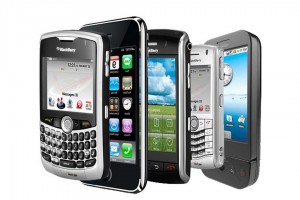Using cell phones overseas is much more complicated than it seems. The production itinerary for our current documentary
calls for us to be shooting in a total of six countries outside the United States. This is, by far, the most ambitious schedule I’ve ever put together. As of this writing, we’ve completed production in two of those countries – Australia and New Zealand – and I can tell you the most volatile line item on our budget was the cost of using cell phones overseas. However, I can also tell you this volatility did not have to be the case. Two examples immediately spring to mind when it came to mistakes I made.

The first stumbling block hit us in the Australian outback at our hotel near King’s Canyon. If you’re heading into this part of the Northern Territory, you should be aware that there is exactly one place to stay, and while it is a real oasis in the desert, you are unquestionably in the hinterlands. It had simply not occurred to me there would not be a cellular signal at our hotel. My assumption was the staff would need to make calls somehow, so there would likely be a cell tower. There was not. Of course, they had the luxury of the hotel’s own landline based system. Travelers who were using cell phones overseas were on their own, and the wifi was billed out in increments of 200MB per $20 AUD. As a documentary producer who needed to keep in touch with the next location’s subjects, this was a very long 48 hours.

The second mishap happened not long after we arrived in New Zealand. The cardinal rule about documentary production is this: if you end the shoot telling the same story you started out to tell… you’re doing it wrong. Of course, our story was changing, and we needed to change with it. This involved changing locations, and changing hotels. I was using hotels.com for most of the bookings (there are pros and cons for the decision, but that’s another article). With no solid wifi signal in our area, I was forced to call the site’s 800 number to make a quick change. I was on the phone for less than fifteen minutes, and was… let’s say miffed… to find out afterwards the call had cost close to $50 USD, because the number was routed through a country that was not included on the list of covered countries in our international calling plan for using cell phones overseas. A gracious customer service representative at T-Mobile gave me a one-time reprieve, but… lesson learned.
I want to go over some of our crew’s revised best practices while shooting on the road and using cell phones overseas. There are pitfalls, but they can be avoided. This first post deals with one big issue, because it is likely the choice you will make when traveling – what to do if you choose to use your own phone. There are other valid options on the road, and they will be discussed in this series of posts, but let’s deal with this one first.
For the purposes of this post, I’m assuming you are using a smartphone – a phone that also has access to the internet and other applications. However, most of this advice will also apply to simple cellphones as well. Of course, using your own phones saves you a lot of time on the front end. Your contacts, preferences, links and apps are all set up the way you like them. You have your own SIM card and your own familiar number. In theory, you can get up and go while using cell phones overseas if you use your own phone.
Not so fast.
I would encourage you to go through the following series of questions and actions before hitting the jetway. Way before hitting the jetway, in fact, because many of these steps are much more difficult to handle on the go.
Tips for using cell phones overseas:
1. Is your phone a GSM phone?
A GSM phone, also known as a quad band phone, is generally the gold standard for international travel and using cell phones overseas. A tri band phone is the next best option, but at a basic level, you need to know whether or not your phone is physically capable of placing and receiving calls around the world. If not, your choice of whether to use your own phone may already have been made by default.
However, you also should check to see if your phone is or can be unlocked so that it can work with other mobile carriers around the world. Thanks to new laws passed by Congress and fully enacted in February of 2015, it’s a lot easier to get your phone unlocked by your carrier. You may need to be 90 days into your contract or have paid off the balance due on your hardware (the phone or tablet), but unlike just a few years ago when domestic United States carriers could refuse to unlock your phone, this is no longer the case. If you do not unlock your phone, you are left with one option…
2. International calling plans
This was the option we had chosen for our company phones, and I will be the first to confess that this convenience does not come cheaply, and it may not have been the best option. Our international calling plan through T-Mobile allowed us to make calls from Australia and New Zealand back to the United States and vice-versa (essential for preproduction planning before leaving), but there was a major catch. While calls from the U.s. to these countries (as well as the others on the plan’s roster) were free, calls from those countries back to the United States would cost .20/minute. This can add up in a hurry. Additionally, calls between the countries covered on the roster were also billed at the same rate of 20 cents per minute.
As of this writing. there is one loophole in the T-Mobile plan. When we were on a wifi network, our phones (iPhones in this case, but there are plenty of Android based phones that have the same feature) could hook into a wifi calling network, bypassing the cell signal entirely. This option was available for calls back to the United States, but sadly, not for calls within or between countries in the international calling plan for using cell phones overseas. Every time I had to place a call between those countries, I silently made that same wail Charlie Brown used to make when Lucy pulled the football away (I believe it was AUGGH!) and wished I had a better plan.
For the four major carriers in the United States, I would urge you to check out their internal calling plan costs and features. You’ll want to do this before even thinking about using cell phones overseas, in order to see if you can get their international plans on a month-to-month basis, and you’ll want to know exactly which countries are on their lists of covered countries. These are the primary links as of this writing in July 2015.
3.Fetching and Roaming
This is the grand poobah of warnings when traveling and using cell phones overseas. If you are not using your phone on a regular basis, and most of us who are not business travelers are not using our phones regularly, you should start getting in the habit of leaving your phone’s cellular signal off when you’re not in your home country and you’re not using an international calling plan. Your phone is working in the background. It’s searching for a cellular signal (roaming) and it’s getting data for you (fetching) for every app you have.. often whether the app is open or not.
I’ve heard more horror stories than I could ever recount of travelers using cell phones overseas who returned to the United States to find hundreds, and sometimes thousands of dollars worth of cellular and data charges on their phone, even though they rarely if ever used their phones. Don’t forget that text messages occur on the cellular network, not wifi, and if you’re using cell phones overseas, each text message counts as cellular data usage. If you find yourself traveling to some locations… Africa and many states of the former Soviet Union come quickly to mind… data rates can start at $5.99 per minute or similarly high fees per megabyte.
You should become intimately familiar with the location within your phone settings menu where you can turn off your cellular signal and its ability to automatically fetch data in the background. Those megabytes add up in a hurry. You can still retain the wifi signal, and the cellular is there if you need it.
When it comes to using your own phone, those are the big three tips. I would add one more caveat… that you need to remember that your smartphone might as well have a holographic bullseye hanging above it, because when you use it in public, you are the most obvious target around for thieves. Yes, it’s harder than ever to repurpose a stolen smartphone thanks to antitheft software and hardware built into newer devices. However, it is also true that not all thieves know this, or care what you’re carrying. Think about how quickly you can get to another phone to report it stolen or have its memory wiped, and then think about how long it will take a hacker who will buy a stolen phone from a thief for a few dollars can get your passwords… and all the personal information beyond it… into their system or the internet black market. There is almost no reason I can think of that would require making a phone call in public, and if you’re using the web features for mapping, reviews or adding pictures to your Instagram feed, weigh all of this against being another robbery victim.
Next up, we’ll look at the next option for using cell phones overseas – ditching your own phone and shacking up with a temporary phone.
Onwards!
